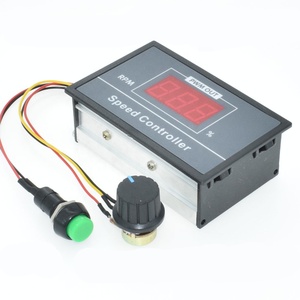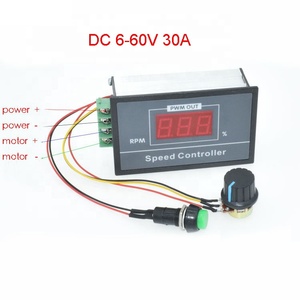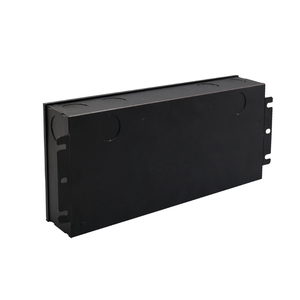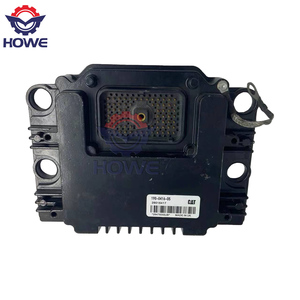
All categories
Featured selections
Trade Assurance
Buyer Central
Help Center
Get the app
Become a supplier

(400 products available)







































There are various types of a pwm dc motor speed controller 30a based on the motor's nature and application. These controllers effectively cater to the needs of different systems.
Brushed DC Motor Controllers
Brushed DC motors are the traditional workhorse. The DC motor speed controller provides these motors with simple and cost-effective solutions. It uses a PWM to control speed and enhance energy efficiency. Often, these controllers include braking and direction control for overall functionality in industrial and automotive applications.
Brushless DC Motor (BLDC) Controllers
BLDC motors have come into play because of their efficiency and longevity. Unlike brushed motors, these require more sophisticated controllers. BLDC speed controllers employ complex PWM algorithms such as trapezoidal or sinusoidal commutation. This helps in providing smooth operation and minimizing vibrations. Found in aerospace, robotics, and consumer electronics, these controllers are vital.
Servo Motor Controllers
Servo motors are precisely controlled devices used in applications requiring accurate position and speed control. Controllers integrate PWM with feedback systems to ensure precision. It's common in robotics, CNC machines, and aerospace systems where performance is vital. These are costly compared to others whose prices are moderately ranged.
Single-chip DC Motor Drivers
Single-chip drivers are compact solutions ideal for low-power applications. They integrate PWM control on a single chip. This makes them suitable for space-constrained devices like mobile phones and small robots. They provide basic speed and direction control but are limited to low-power motors.
Dual-channel Controllers
These controllers manage two motors simultaneously. They are useful in differential drive systems found in mobile robots and electric vehicles. Dual-channel controllers provide synchronized control using PWM to maintain equal speeds on both motors. They are essential in applications that require mobility and precise maneuvering.
Sensorless Controller
These controllers control brushless motors without requiring position sensors. They detect rotor position through back EMF, controlling speed via PWM. Sensorless controllers are cost-effective. They work by eliminating the need for sensors while maintaining efficiency. They are mainly used in applications where costs are saved, like in electric bikes and fans.
Industrial Automation
In industrial automation, electrical motor controllers are used to regulate the operations of machinery. These machines, such as conveyor belts and pumps, require precise control of speed and torque to optimize production. By efficiently managing energy consumption, they enhance system reliability, reduce wear on components, and minimize downtime.
Robotics
Robots heavily rely on motor controllers for mobility and task execution. Be it a mobile robot or robotic arms, these controllers provide the needed precision in movement and positioning. This enables robots to perform intricate tasks at varying speeds. The key role of controllers in energy management makes them indispensable in extending operational time in robotics.
Automotive Systems
Automotive systems use controllers to manage electric windows, seats, and wipers. They control brushless and brushed DC motors for smooth functioning. For electric vehicles, motor controllers are vital for efficient power management between batteries and drive motors. This ensures optimal performance.
Consumer Electronics
Consumer electronics use motor controllers in devices like fans, hard drives, and washing machines. They control motor speed and direction via PWM for efficient and quiet operations. This enhances user experience and reduces power consumption, especially in battery-operated devices.
Aerospace
In the aerospace industry, motor controllers manage critical systems such as actuators. They control flaps, landing gear, and guidance systems. These controllers are essential for maintaining accuracy and reliability. They provide robust speed control for electric DC motors in dynamic environments.
Precise Speed Control
A 30 amp dc motor controller speed control varies motor speed by adjusting the voltage proportion. Its precision ensures applications requiring variable speed, such as conveyor systems, receive the right amount of motor power.
Directional Control
Direction control is done using a simple change of two input terminals. This feature enables motors to reverse or switch operational directions. It is crucial for tasks like material handling, where direction alternation is often necessary.
Overload Protection
There is an automatic shutdown feature on overloads that protect the system and extend the lifespan of components. This ensures operations remain within safety limits, reducing risks in high-load industrial settings.
Heat Sinking
Heat sinks dissipate generated heat during operations. This helps in maintaining optimal performance. By preventing overheating, they ensure the controller functions efficiently for a longer time in strenuous applications.
Regen Braking
Regenerative braking recovers energy during motor deceleration and braking. The energy is then fed back into the power supply system. Therefore, improving energy efficiency in electric vehicles and lift systems that frequently brake.
Opto-isolation
Opto-Isolation separates control signals from the power circuit. This ensures safety and protects the system from voltage spikes. This feature is valuable in high-power applications to prevent damage to sensitive electronics.
Safety Precautions
Precautionary measures are a must to avoid any electrical accidents. These include disconnecting the power source and wearing insulated gloves. Reviewing the equipment manuals will provide specific details on the installation processes and potential hazards.
Mounting the Controller
The controller should be mounted in a cool and safe area where there is easy access for maintenance. There should no exposure to excessive dust, humidity, or temperature. There should an appropriate heat sink for cooling purposes.
Wiring Connections
Secure the desired terminals after identifying the motor, power supply, and battery terminals. Ensure the wiring follows the color-coding system. Close attention should also be paid to the direction control wires for the correct motor operation.
Signal Connections
Connection of the control inputs, such as throttle or potentiometer, should be done using appropriate devices. This will help in ensuring the speed control signal is received. Refer to the manual for specifics on the required signal wiring and configurations.
Testing
Reconnect the power source after completing all wiring connections. Perform operational tests at low speeds. This helps in checking the wiring and controller functionality.
Routine Maintenance
Routine maintenance is vital for a controller's longevity. Regular cleaning should be done to remove dust and debris. This can be accomplished by using compressed air or a soft brush. Regular inspection of wiring for signs of wear or damage should be conducted. They should be replaced with new ones to avoid further complications.
Temperature Monitoring
The above monitoring ensures that the controller does not overheat during usage. Engage cooling methods such as heat sinks and fans. Power limits should also be observed not to exceed beyond the specified range since overheating will be caused by excess power.
Firmware Updates
Occurrence of updates will ensure that the controller runs on the latest software for optimal performance. This can be done by visiting the manufacturer's website for the latest version or using the tools required for installation.
Component Replacement
Maintenance of capacitors, resistors, and other peripherals can be accomplished by maintenance personnel. They should, however, possess the necessary skills. Complex repairs like PCB damage should only be handled by a professional.
Sensors Calibration
For controllers with built-in sensors, calibration should be done according to the manufacturer's instructions. Improper calibration will lead to inaccurate readings and improper functioning.
Material and Components
The controller's materials and components directly impact durability and performance. Premium quality parts ensure better heat dissipation, higher reliability, and resistance to wear. This reduces long-term maintenance needs while enhancing operational efficiency.
Testing and Certification
Controllers with certifications from recognized bodies meet industry standards for safety and performance. This tests them under various conditions to ensure reliability in critical applications. Purchasing certified products means lower chances of unexpected failures.
Manufacturing Standards
Ensure the product is from a reputable manufacturer who follows strict quality control processes. This guarantees consistency in performance. Quality controllers reduce paired motor wear and application downtime and enhance smoother operations.
Technical Support
Availability of technical support and documentation drastically reduces troubleshooting times. This enables quick recovery from issues. Support and resources help users understand and optimize the controller. This enhances lifespan and performance.
Overload Protection
This prevents the controller and connected motors from exceeding their rated limits. The controllers automatically reduce power or shut down in case of detected overload. This protects equipment from damage and reduces hazards in industrial environments, as equipment failure can cause safety risks.
Heat Management
Proper heat management using heatsinks or fans is vital for safety. Controllers without adequate cooling may overheat, leading to fires or damage to surrounding equipment. A good controller will have safeguards against excessive heat.
IP Rating
Ingress protection ratings determine what level of water or dust exposure is allowed in the controller. Ensure the controller is rated appropriately for the environment. This will prevent electrical hazards and prolong its lifespan.
Emergency Stop
Many controllers have E-stop features. In case of any emergency, the system will shut down all motor activities, minimizing risks. This is especially important in industrial settings where quick power-off can prevent injury.
Electrical Isolation
Good controllers have opto-isolation between control and power circuits. This reduces the risk of electrical shock and protects sensitive electronics from voltage spikes. It is vital for user safety and equipment protection.
A1: PWM denotes the method of controlling average voltage delivered to a load by switching it on and off rapidly. This technique is efficient for controlling devices like motors, heaters, and lights. The speed controller varies motor speed by adjusting the PWM duty cycle, providing precise and energy-efficient control for various applications.
A2: The controller efficiently manages motor speed and direction using PWM. This minimizes energy waste, particularly in battery-powered devices. Its compact design allows easy integration into tight spaces or systems. It is also durable, often rated for harsh conditions, and suitable for varied applications requiring reliable control.
A3: DC motors, both brushed and brushless, are ideal for use with PWM controllers. These motors benefit greatly from precise speed and direction control. Enhanced efficiency and smoother operation are provided by the controller, making it suitable for various applications, including robotics and automotive.
A4: PWM controllers are used to enhance battery life and driving range in electric vehicles by efficiently controlling motor speed and torque. They manage power delivery, reducing energy loss, especially during acceleration and deceleration. This offers a smoother ride with less heat generation.
A5: Using a PWM controller on AC motors is not recommended since these controllers are designed for DC motors. AC motors require different types of controllers, like VFDs. These efficiently manage power by controlling frequency and voltage, providing smooth operation in applications with extensive industrial drives.